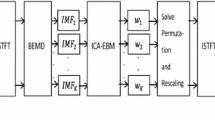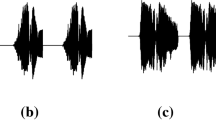Abstract
Aiming at the problem of electromagnetic interference signal separation, we propose a single-channel blind source separation method based on complete ensemble empirical mode decomposition with adaptive noise (CEEMDAN) and independent component analysis (ICA). Firstly, decompose the mixed interference signal by CEEMDAN to obtain a series of intrinsic mode functions (IMF). Secondly, combine them into a new multi-dimensional signal and solve its correlation matrix, and use singular value decomposition to obtain the eigenvalues of the matrix, and then use it to estimate the source number. Thirdly, select those IMFs whose correlation coefficients with the observed signal are bigger and regard them together with the original signal after denoising as new observed signals. Finally, recover the source signals by fast independent component analysis (Fast-ICA). We also extend our method to multi-channel BBS, and experiment results show that our method can eliminate unnecessary noise in the signal and perform well.












Similar content being viewed by others
Explore related subjects
Discover the latest articles, news and stories from top researchers in related subjects.References
Ji J, Chen W, Yang X (2016) Design and precise modeling of a novel Digital Active EMI Filter. In: 2016 IEEE Applied Power Electronics Conference and Exposition (APEC), Long Beach, CA, 2016, pp 3115–3120
Kovačević IF, Friedli T, Müsing AM, Kolar JW (2014) 3-D electromagnetic modeling of parasitics and mutual coupling in EMI filters. IEEE Trans Power Electron 29(1):135–149
Li H, Wang C, Zha D (2015). An improved EMD and its applications to find the basis functions of EMI signals. Math Problems Eng
Fu K, Qu J, Chai Y et al (2014) Classification of seizure based on the time-frequency image of EEG signals using HHT and SVM. Biomed Signal Process Control 13:15–22
Huang NE et al (1998) The empirical mode decomposition and the Hilbert spectrum for nonlinear and non-stationary time series analysis. Proc R Soc Lond Ser A: Math Phys Eng Sci 454(1971):903–995
Lei Y, Lin J, He Z, Zuo MJ (2013) A review on empirical mode decomposition in fault diagnosis of rotating machinery. Mech Syst Signal Process 35:108–126
Alam SMS, Bhuiyan MIH (2013) Detection of seizure and epilepsy using higher order statistics in the EMD domain. IEEE J Biomed Health Inf 17(2):312–318
Zhu B, Wang P, Chevallier J et al (2015) Carbon price analysis using empirical mode decomposition. Comput Econ 45(2):195–206
Hongying H, Wenlong L, Fengqiang Z (2013) Study on two mode-mixing resistant empirical Mode Decomposition methods. In: 2013 10th International Conference on Fuzzy Systems and Knowledge Discovery (FSKD), Shenyang, 2013, pp. 1040–1044
Wu ZH, Huang NE (2009) Ensemble empirical mode decomposition: a noise assisted data analysis method. Adv Adapt Data Anal 1(1):1–41
Yeh JR, Shieh JS, Huang NE (2010) Complementary ensemble empirical mode decomposition: a novel noise enhanced data analysis method. Adv Adapt Data Anal 2(2):135–156
Torres ME, Colominas MA, Schlotthauer G et al (2011) A complete ensemble empirical mode decomposition with adaptive noise. In: Proceedings of 2011 IEEE international conference on acoustics, speech and signal processing. Prague: IEEE, 2011:4144–4147
Artoni F, Delorme A, Makeig S (2018) Applying dimension reduction to EEG data by Principal Component Analysis reduces the quality of its subsequent Independent Component decomposition. NeuroImage 175:176–187
Barhatte AS, Ghongade R, Tekale SV (2016) Noise analysis of ECG signal using fast ICA. 2016 Conference on Advances in Signal Processing (CASP), Pune, 2016, pp 118–122
Zhu N, Bai X, Dong W (2013) Harmonic detection method based on EEMD[C]//Zhongguo Dianji Gongcheng Xuebao(Proceedings of the Chinese Society of Electrical Engineering). Chin Soc Electr Eng 33(7):92–98
Fengrong BI, Di LU, Kang S (2015) Blind source separation and identification of loader indoor noise based on EEMD-ICA-CWT. J Tianjin Univ 48(9):804–810
Fontgalland G, Pedro HJG (2015) Normality and correlation coefficient in estimation of insulators’ spectral signature. IEEE Signal Process Lett 22(8):1175–1179
He Q, Song H, Ding X (2016) Sparse signal reconstruction based on time-frequency manifold for rolling element bearing fault signature enhancement. IEEE Trans Instrum Meas 65(2):482–491
Wang C, Huang H, Zhang Y et al (2019) Variable learning rate EASI-based adaptive blind source separation in situation of nonstationary source and linear time-varying systems. J VibroEng 21(3):627–638
Andrzejak RG, Lehnertz K, Mormann F et al (2001) Indications of nonlinear deterministic and finite-dimensional structures in time series of brain electrical activity: dependence on recording region and brain state. Phys Rev E 64(6):061907
Nejad MRE, Rizi FY (2018) An Adaptive FECG Extraction and Analysis Method Using ICA, ICEEMDAN and Wavelet Shrinkage. In: Iranian Conference onElectrical Engineering (ICEE), Mashhad, 2018, pp. 1429–1434
Tichavský P, Koldovský Z, Doron E, Yeredor A, Gómez-Herrero G (2006) Blind signal separation by combining two ICA algorithms: HOS-based EFICA and time structure-based WASOBI. 2006 14th European Signal Processing Conference, Florence, 2006, pp 1–5
Herrero GG, Koldovsky Z, Tichavsky P, Egiazarian K (2007) A fast algorithm for blind separation of non-Gaussian and time-correlated signals. In: Proceedings of 15th European signal processing conference (EUSIPCO 2007), pp 1731–1735
Acknowledgements
This work was supported by the National Natural Science Foundation of China (Grant No. 61771001).
Author information
Authors and Affiliations
Corresponding author
Additional information
Publisher's Note
Springer Nature remains neutral with regard to jurisdictional claims in published maps and institutional affiliations.
Rights and permissions
About this article
Cite this article
Zhao, D., Li, K. & Li, H. A New Method for Separating EMI Signal Based on CEEMDAN and ICA. Neural Process Lett 53, 2243–2259 (2021). https://doi.org/10.1007/s11063-021-10432-x
Accepted:
Published:
Issue Date:
DOI: https://doi.org/10.1007/s11063-021-10432-x




